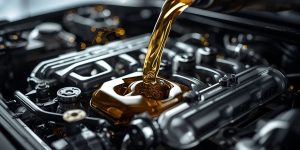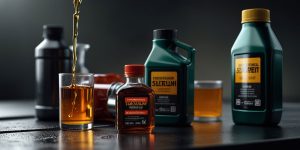In today’s fast-evolving automotive industry, automotive lubricants play a critical role in keeping vehicles running efficiently and reliably. These vital fluids do far more than just reduce friction—they help cool components, prevent corrosion, clean internal parts, and extend the life of your vehicle.
Whether you’re a car owner, mechanic, or an industry professional, understanding how lubricants work and which type is suitable for your vehicle is essential for optimal performance. In this comprehensive guide, we’ll explore the science behind lubricants, their types, composition, applications, market relevance , and much more.
The Basics of Automotive Lubricants
Automotive lubricants are fluid-based substances designed to reduce friction between moving mechanical components within vehicles. They serve as a protective barrier, minimizing direct contact between metal parts, thereby reducing wear, heat generation, and energy loss.
Some of their key roles include:
- Reducing friction and surface wear
- Cooling engine and transmission components
- Preventing corrosion and rust formation
- Cleaning contaminants and debris
- Ensuring smooth operation of moving parts
- Enhancing fuel efficiency and performance
Without proper lubrication, engine components would overheat and wear out prematurely, leading to costly repairs or total system failure.
How Do Automotive Lubricants Work?
The effectiveness of a lubricant depends primarily on its viscosity, which refers to its resistance to flow. A lubricant must be thin enough to flow easily at low temperatures (e.g., during cold engine starts) and thick enough to maintain a protective film at high temperatures.
Here’s how they work:
- Viscous layer formation: Lubricants form a thin film between metal surfaces, preventing direct contact.
- Heat dissipation: By circulating through the engine or transmission, lubricants carry heat away from critical areas.
- Contaminant suspension: Additives in lubricants help suspend dirt, soot, and metallic particles, keeping parts clean.
- Seal protection: Some lubricants also help maintain seals and prevent leakage.
Using the right viscosity grade (e.g., 5W-30, 10W-40) ensures the lubricant performs well in both summer and winter conditions.
Composition of Lubricants
Every automotive lubricant consists of two main components:
- Base Oils
Base oils make up around 70% to 90% of a lubricant’s volume. They determine the fundamental characteristics such as viscosity, oxidation stability, and thermal conductivity. There are two primary categories:
- Mineral Base Oils: Derived from refining crude oil, they are classified into:
- Group I: Least refined, lower performance
- Group II: More refined, better oxidation stability
- Synthetic Base Oils: Engineered in labs for higher performance
- Group III: Highly refined mineral oil treated to act like synthetic
- Group IV & V: True synthetics offering top performance in extreme conditions
- Additives
Additives account for 10% to 30% of the lubricant and serve to enhance or introduce new properties. Common additives include:
- Anti-wear agents (e.g., ZDDP)
- Detergents and dispersants to keep engines clean
- Viscosity index improves to stabilize performance across temperatures
- Anti-oxidants to extend oil life
- Corrosion inhibitors to protect metal parts
Different lubricant formulations use various blends of base oils and additives, depending on the specific application requirements (e.g., engines, transmissions, gears, hydraulics).
Types of Automotive Lubricants
There are several types of lubricants used across different systems in a vehicle. Here are the most common categories:
- Engine Oils
These lubricants are used in internal combustion engines to reduce friction, clean engine parts, and carry away heat.
- Multigrade oils like 5W-30 or 10W-40 adjust to temperature changes
- Synthetic oils offer superior performance under high-stress conditions
- Semi-synthetic oils are a blend of mineral and synthetic
- Transmission Fluids
Used in gearboxes to enable smooth shifting and protect components from wear:
- Automatic Transmission Fluid (ATF): Contains friction modifiers and seal conditioners
- Manual Transmission Fluid (MTF): Higher viscosity and heat resistance
- CVT Fluids: Specialized for Continuously Variable Transmissions
- Gear Oils
Specifically designed for high-pressure gear mechanisms like differentials and manual gearboxes. They typically have higher viscosity and extreme pressure additives.
- Greases
Semi-solid lubricants used in wheel bearings, joints, and brake components. They consist of base oil + thickener (usually soap-based) + additives.
- Molybdenum disulfide grease is widely used for heavy-duty automotive parts.
- Hydraulic Oils
Used in systems where fluid is required to transfer force, such as power steering and braking systems. These oils must resist foaming, oxidation, and maintain stability under pressure.
Applications and Benefits of Automotive Lubricants
Automotive lubricants are engineered not just to keep a vehicle running, but to enhance its efficiency, longevity, and reliability. The proper use of lubricants directly impacts overall vehicle health, especially in demanding environments.
Key Applications
- Engine lubrication: Keeps pistons, bearings, and crankshafts moving smoothly without direct contact.
- Transmission systems: Ensures seamless gear shifts and protects transmission components from friction.
- Differentials and gearboxes: Withstand high loads and pressure using gear oils.
- Chassis parts: Greases protect wheel bearings, suspension joints, and brake pins.
- Hydraulic systems: Fluids transfer pressure in braking and steering mechanisms.
- Cooling systems: Engine oils play a secondary role in heat transfer from hot surfaces.
Top Benefits of High-Quality Lubricants
- Reduced Friction and Wear
Less friction means less energy loss and decreased wear on metal surfaces — crucial for engine durability. - Improved Fuel Efficiency
A properly lubricated engine runs more efficiently, reducing fuel consumption over time. - Corrosion and Rust Protection
Lubricants prevent oxygen and moisture from coming into direct contact with metal surfaces. - Cleaning and Contaminant Control
Dispersants and detergents suspend sludge and carbon particles, keeping the engine clean inside. - Heat Dissipation
Lubricants absorb and carry heat away from hot spots such as piston rings and bearings. - Extended Engine Life
Regular use of premium lubricants helps delay wear-and-tear, reducing the need for costly overhauls. - Emission Reduction
Cleaner engines burn fuel more efficiently, reducing harmful exhaust gases.
Vehicle Type & Volume Trends
- Passenger vehicles remain the dominant application segment, while engine oils continue to hold the largest product share in the automotive category .
Growth Drivers & Market Dynamics
- Key drivers include:
- Rising demand for personal cars, two‑wheelers, commercial vehicles, and improved road infrastructure.
- Growing consumer awareness of the benefits of premium oils and regular oil changes.
- Policy support for infrastructure, mobility and freight corridors boosting commercial vehicle fleets
- However, the accelerating adoption of electric vehicles (EVs) is expected to gradually reduce demand for conventional lubricants, opening opportunities for specialized EV fluids
Environmental Impact and Eco-Friendly Lubricants
While automotive lubricants are essential for vehicle operation, they also come with environmental consequences—especially when improperly disposed of. Used engine oils can contain toxic substances such as heavy metals, combustion by-products, and volatile organic compounds (VOCs), which can contaminate soil and groundwater.
Environmental Challenges
- Oil Spillage: Accidental leakage or dumping of used lubricants can harm ecosystems and aquatic life.
- Air Pollution: VOCs in lubricants can evaporate and contribute to smog formation.
- Waste Disposal: Disposing of used oil in landfills or sewage systems poses significant risks.
Eco-Friendly Alternatives
To counteract these challenges, manufacturers and regulators are pushing for greener lubricant solutions:
- Biodegradable Base Oils: Lubricants made from synthetic esters or vegetable oils degrade more easily in the environment.
- Low-VOC Formulations: These reduce emissions and air pollution during use.
- Re-refined Base Oils (RRBOs): Used oil is chemically treated and purified for reuse, reducing the need for virgin crude.
- Eco-Certified Products: Brands now offer lubricants certified by global eco-labels for use in sensitive environments.
Industry Shifts
- Leading brands like SiNDA, are investing in research to develop low-emission, fuel-saving lubricants.
- Some products are now formulated specifically for hybrid and electric vehicles (EVs), focusing on lower energy drag, dielectric strength, and thermal stability.
As environmental regulations tighten, eco-friendly lubricants are expected to play a much larger role in India’s automotive future.
Conclusion
Automotive lubricants are far more than just oil—they are the lifeblood of modern vehicles, ensuring smooth performance, reduced wear, and extended engine life. Whether it’s engine oil, transmission fluid, or specialized greases, the right lubricant makes a measurable difference in fuel efficiency, maintenance costs, and vehicle longevity.
In World’s rapidly growing automotive market, choosing high-quality lubricants from trusted brands like SiNDA Oil is not just a preference—it’s a necessity. With increasing environmental awareness and evolving engine technologies, the future of lubricants lies in sustainable, high-performance formulations tailored for both internal combustion and electric vehicles.
When you invest in the right lubricant and follow regular maintenance schedules, you’re not just protecting your engine, you’re securing the long-term health of your vehicle and reducing its environmental footprint.
FAQs
- What are automotive lubricants used for?
Automotive lubricants reduce friction between moving parts, help dissipate heat, prevent corrosion, and keep engine components clean.
- What is the difference between mineral oil and synthetic oil?
Mineral oils are derived directly from crude oil refining, while synthetic oils are chemically engineered for better stability, performance, and longevity under extreme conditions.
- How often should I change engine oil?
It depends on the vehicle and oil type. Generally, change intervals range from 5,000 to 10,000 km, but always follow your manufacturer’s recommendation.
- Can I mix different types of lubricants?
Mixing is not recommended unless specified by the manufacturer. Combining different formulations can reduce performance and may cause chemical incompatibility.
- Are eco-friendly lubricants effective for high-performance vehicles?
Yes. Many modern biodegradable or low-VOC lubricants are engineered to meet or exceed the performance of conventional products, even in high-stress applications.
- What should I look for when choosing a lubricant?
Check for:
- Compatibility with your vehicle’s engine type
- API/ACEA performance ratings
- Suitable viscosity grade (e.g., 5W-30)
- Trusted brand with a proven track record
- Environmental certifications if sustainability matters to you











